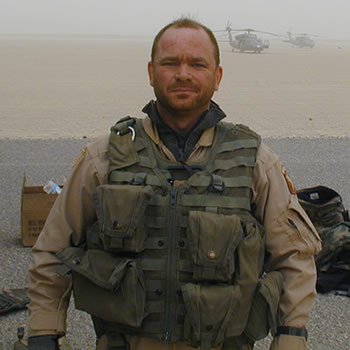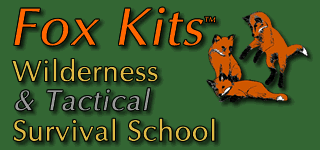Survival in Iraq, 24 March 2003
The sky was black and brown. We
were enveloped by smoke from oil wells that Saddam had ordered set afire.
The further we moved Northward the worse the weather got. The winds were
blowing dust so hard that it was difficult to see much farther than the
aircraft in front of us, which wasn’t more than 100 feet. We felt
obligated to continue though, because we were carrying heavy metal boxes
hung below our aircraft that contained Apache helicopter parts desperately
needed at their destination. The winds picked up even more and the aircraft
became almost uncontrollable. My aircraft was flung past the aircraft
in front of me by winds in excess of 70 knots. And at one point while
being tossed about, the load beneath our aircraft came within 10 feet
of the ground! We climbed and the load became so unstable that I had to
jettison it before it caused us to crash.
As we climbed above the blowing dust I
looked down at the fuel gauge and my heart sank – the gauge read
less than 500 pounds of gas! That isn’t much for such a big aircraft.
I decided that the best thing to do was to turn into the wind and begin
a controlled descent in an attempt to land. At 1100 feet the ground came
into sight but then disappeared. We picked it back up again at around
100 feet and safely landed. Once on the ground there was a collective
sigh of relief from all crewmembers.
The problem now was that we were still 25 km
from our destination, fuel critical and unable to talk with the other
aircraft in our flight. We decided to continue toward our destination
hovering forward low to the ground, and at times, rolling on our wheels
across the desert! Every inch closer to friendlies was one less inch we
had to walk and that much closer to rescue! We had only a couple of minutes
of fuel remaining and had only moved 6 km.
Heath, my co-pilot, attempted to contact our
unit on the long range High Frequency (HF) radio to give our position.
As he was making contact we were creeping forward at about 15 feet above
the ground when the #1 engine flamed out and almost immediately the #2
engine flamed out too. I performed a hovering autorotation and floated
the aircraft safely to the ground. I immediately started the Auxiliary
Power Unit (APU) so that our radios would have power. Heath reset the
HF radio because of the power fluctuation and tried to send our position
again but it didn’t get through. Then our APU flamed out. We sat
there for a few seconds contemplating what to do next.
We were still 19 km from our destination according
to our Global Positioning System (GPS). The visibility was no more than
200 yards due to blowing dust and sand. We thought that we saw enemy vehicles
moving toward us but, thank God, they turned out to be bushes that were
being shaken by the extremely high winds.
We discussed walking to our original destination
and joked that since it was over 12 miles we could get credit for the
annual 12 mile road march training requirement. We were serious about
walking to friendly forces but decided that we should wait until after
dark when it was cooler because we remembered that BK Fox had taught us,
“conserve sweat, not water”. It was 12:30 p.m. local time
so we would have to wait at least 5 hours before starting our trek.
We sat there keeping a vigilant watch for enemy
vehicles. At one point the visibility picked up to about 500 yards and
to our North we saw what appeared to be a small convoy and a possible
encampment. Later we discovered that it was only more bushes.
We moved away from the aircraft. Two of us manned
the M60 door guns while the other two dug hasty fighting positions in
the bushes and low ground a safe distance from the aircraft. As we moved
the last of our equipment to our positions I took the hand-held survival
radio out of my vest and attempted to call for help. No answer. I tried
a few more times and then turned the radio off to save the battery. Later
I climbed onto the top of the aircraft to try for better reception. I
was a bit nervous in this because being up there I would be in a pretty
vulnerable position should we get attacked. After a couple of tries I
finally reached a friendly aircraft. We authenticated each other (made
sure the other was friendly) and I told him that we were a downed aircrew
with both engines flamed out and all 4 crewmembers are safe with no injuries.
We set up a communication schedule so that I could conserve battery power
on my radio.
The wind was still blowing very hard and visibility
was still poor. We thought we heard vehicles approaching but the sounds
turned out to be the wind whipping through our aircraft. Isolation in
a hostile environment sure makes for an active imagination!
We were relieved when we were finally able to
give the aircraft we were talking with our position using an encryption
code. It meant that friendlies could now start working their way to us.
About 5 minutes later two F-15’s flew overhead. They got down to
about 100 feet above the ground and flew over top of our position rocking
their wings and giving us a thumbs-up. We all stood up and waved and returned
the greeting. Heath said, “he was so low I could almost read his
nametag.” Our new best friend did a climb straight up and then said
he had to go for fuel and would be back in 30 minutes. Around sunset we
talked to our friend again and told him we were planning to walk to our
destination after dark. He told us to maintain current position that someone
was on the way. We were positive that we’d be picked up soon.
When it was my turn for guard shift I grabbed
my Night Vision Goggles (NVGs) and started roving. I spoke with another
pilot who told me he had 2 helicopters and was guiding them to our position.
I looked out to the horizon and saw their infra-red search lights coming
right for our position. I awakened the crew to prepare for recovery and
about then the lights, which were about 8-10 miles away, turned and disappeared
into the distance. Disappointed again.
As the night progressed I noticed that my crew
members were getting cold. The temp had dropped and we didn’t have
much warm gear in the fighting positions. I woke SPC Phelps and asked
him to come to the aircraft to help me find the sleeping bags and bring
them back to the fighting positions. We continued pulling shifts and monitoring
the radio. At sunup the next morning a team of infantrymen from the Rakkasans
showed up to provide a covering force for us. We were greatly relieved
to have friendly faces show up.
When we returned to the unit area one of the
first things I wanted to do was find BK Fox and thank him for the survival
training. Everything he taught us worked and facilitated our being found.
I credit our survival and safe return to the training we received from
BK.
Thanks BK!

Mark Ilg
CW3 (RET)
Copyright © 2004-2016, Fox Kits Wilderness
& Tactical Survival. All text, graphics, design and other works are
the property of Fox Kits. All Rights Reserved.
The following are protected trademarks of Fox Kits
Fox Kits™
We have what you need to survive!™
We teach confidence!™
Quality you can count on - Confidence you can live with!™
Fox Kit Logo (three fox kits)
All other registered and unregistered trademarks belong to their respective
owners and are used in marketing their products and services.
Use of this site, and the terms and conditions for the
sale of goods and services is governed by our terms of service agreement.
By using this site or purchasing goods you acknowledge that you have read
the terms of service agreement and the disclaimers
and caveats contained in this site, and that you accept and will be bound
by the terms thereof.
For any questions or comments please feel free to contact us.

